
|
History of Sex in Cinema: 1964 |
| Movie Title/Year and Film/Scene Description | ||||||||||||||||||||||||||
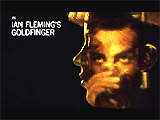
|
Goldfinger (1964, UK) In the third James Bond 007 film Goldfinger (1964), James Bond (Sean Connery) delivered a number of sexy double entendres, one of his many traits. He first met pretty Jill Masterson (Shirley Eaton), the blonde assistant/escort of the film's main villain Auric Goldfinger (Gert Frobe), when he entered the cheater's hotel room. He found Jill reclining on the balcony using high-powered binoculars to report on the cards of Auric's opponent through an earpiece. He cautioned her: "You're much too nice to be mixed up in anything like this." Bond threatened cheater Auric to lose $15K or he would call the local Miami police on him, and Goldfinger in rage broke his pencil in two. The free-spirited Jill then encouraged Bond: "I'm beginning to like you, Mr. Bond...More than anyone I've met in a long time, James." He invited her to "the best place in town" for dinner - and then Bond romanced-seduced Jill on the balcony. He later bedded down with her in his own hotel suite with room-service catering, including Dom Perignon '53 champagne. The couple were interrupted when he received a call from CIA agent Felix Leiter (Cec Linder) for dinner, and Bond declined: "I'm sorry, I can't. Something big's come up," agreeing to a 9 am breakfast instead. As Bond laid on top of Jill and commented: "It's lost its chill," he was referring to a champagne bottle on ice near the bed. When he went to the refrigerator to get another freshly-cooled bottle of "passion juice," he was knocked out from behind by Auric's henchman Oddjob (Harold Sakata). When he revived, he staggered into the bedroom, finding Jill as an unfortunate victim of skin suffocation by gold paint as retaliation for her betrayal. She was sprawled dead and naked on the bed - an unfortunate victim of Goldfinger's revenge. He reported the murder to Leiter: "She's covered in paint. Gold paint." The film also featured Honor Blackman as sexily-named Bond Girl "Pussy Galore." See this site's section on Greatest James Bond Girls. |
 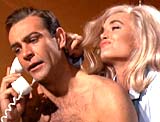 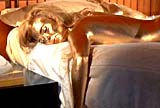
Jill Masterson (Shirley Eaton) |
||||||||||||||||||||||||
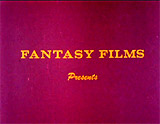 (The film's title was verbally spoken, after this initial screen) |
Kiss Me Quick! (1964) Peter Perry's science-fiction, "monster nudie-cutie" film, from sleaze producer Harry Novak (his first produced film), was a zany, horror comedy - with exceptional cinematography by Laszlo Kovacs, who went on to shoot Easy Rider (1969), Five Easy Pieces (1970), Paper Moon (1973), Shampoo (1975), and Ghostbusters (1984), among others. The sexist film had an incredulous plot about effeminate and asexual Sterilox (Frank Coe), an ambassador from the Buttless Galaxy and the all-male planet of Droopeter. He was teleported to Earth, to the castle of demented Dr. Breedlove (Max Gardens) (a character similar to Kubrick's Dr. Strangelove (1964) with dark glasses, a neck brace, and a black-garbed left arm, and Universal Studios' Frankenstein films). Sterilox's objective was to find the perfect female specimen to breed a race of servants. Dr. Breedlove attempted to perfect a potion of Sex Fizz, offered to his three Sex Bombs in order to get them gyrating and undulating their hips and breasts ("Dance, dance, you little Sex Bombs!"). The three Sex Bombs, buxom burlesque dancing strippers to the tune of 60s surfing music, were:
He also watched a lengthy strip-tease performed by Breedlove's activated robotic Gertie Tassle (Althea Currier).
Unimpressed by them, Sterilox asked to see more women, and Dr. Breedlove complied by switching on his Closed Circuit Television Peeper Vision Device. When Sterilox looked through a portal to check out prospective experiments in "Catacombe 69," he saw many more females, dressing, undressing, etc. and working out in an exercise room. Meanwhile, the Three Sex Bombs went swimming in a kiddie pool, while covering their privates with pool toys. Eventually, Breedlove's 'girl Friday' KissMe (Jackie De Witt) (who at the beginning of the film was in a supine position when she used Breedlove's sex machine without his permission) - after she took off her top - accompanied Sterilox on his journey home.
A new shipment of females arrived on Breedlove's conveyor belt, to be labeled with rating stickers ("Choice," "Prime," "Kosher" (for the woman with panties) or "Reject" - like meat. |
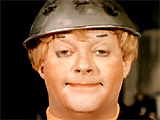 Sterilox (Frank Coe) 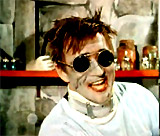 Dr. Breedlove (Max Gardens) 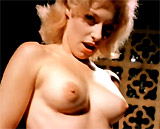   In the Exercise Room with a Vibrating Belt 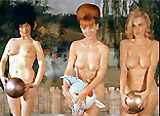 The Three Sex Bombs In a Kiddie Swimming Pool  The Conveyor Belt |
||||||||||||||||||||||||
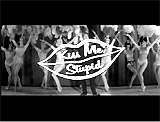
|
Kiss Me, Stupid (1964) Now rated PG-13, this crude, sordid and lesser film about debauchery (marital and extra-marital sex) from director Billy Wilder received a condemned rating from the Catholic Legion of Decency for its allegedly smutty and vulgar tale. It was the first major Hollywood film to be "condemned" following Baby Doll (1956). To avoid controversy, UA shifted the film's publicity and distribution to their art-house subsidiary, Lopert Films. The foundation for the suggestive film was Anna Bonacci’s 1944 Italian bedroom farce L’Ora della Fantasia, which had been adapted into a play titled The Dazzling Hour. It was also based on the subsequent Italian film Wife For a Night (1952, It.), starring Gina Lollobrigida. The farcical sex romp told about an opportunist, amateur songwriter and neurotic piano teacher Orville J. Spooner (Ray Walston) who was married to beautiful wife Zelda (Jack Lemmon's real-life wife Felicia Farr). When heavy-drinking, Las Vegas entertainer and suave playboy Dino's (a depraved, self-parodying Dean Martin) Italian sports-car was sabotaged by deceitful gas station owner Barney Millsap (Cliff Osmond) in their town of Climax, Nevada, he became stranded. Aspiring lyricist Barney was hoping to help his partner Orville sell his songs to the crooner during his overnight visit. The jealous Orville hired naughty and buxom roadhouse cocktail waitress/floozy Polly the Pistol (Kim Novak), who worked in The Belly Button on the edge of town, to pose as his wife Zelda for $25 for a night. He was concerned that his marriage was in jeopardy, knowing that Dino's insatiable, horny amorous attentions would be focused on Zelda. (Zelda had a long-standing juvenile crush on Dino, evidenced by her presidency of the Dino fan club in high school.) And one-track-minded Dino claimed he suffered debilitating migraines if he didn't get laid every night! It was a case of swapped identities and sexual partners, when Orville treated Polly as his wife (and spent the night with her), and Zelda (who had fled to the Belly Button) was mistakenly thought to be Polly by Dino and succumbed adulterously to his sexual desires.
|
 Orville (Ray Walston) and Zelda (Felicia Farr) 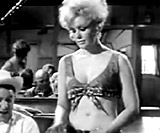 Polly the Pistol (Kim Novak)  Polly and Dino (Dean Martin)  Zelda |
||||||||||||||||||||||||
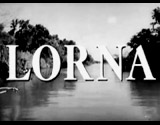
|
Lorna (1964) After an era of 'nudie-cutie' films from 1959 to 1963, sexploitation film-maker Russ Meyer turned to this low-budget 'roughie' rape-revenge film - a noirish melodrama starring 42C big-bosomed voluptuous star Lorna Maitland. Some states prosecuted the backwoods infidelity and rape film for obscenity. The rural sex film, a morality tale, was advertised with the tagline:
Voluptuous Lorna (Lorna Maitland) was a lonely and unsatisfied married woman (the ads said she was "too much for one man") - on the one year anniversary of her marriage. While her husband Jim (James Rucker) worked at a salt mine during the day, she left her run-down shack and strolled through a field (in skimpy, skin-tight shorts) to a swampy lake. As she stood by the water's edge, she removed her blouse and shorts and went for a nude swim. Afterwards, she climbed out, wiped herself dry, dressed, and then laid down in the grass to rest.
An escaped convict (Mark Bradley) came up to her with a lascivious look on his face. She backed up to a tree before standing up, as he confronted her. He grabbed her and forced her to kiss him, while she resisted his advances. She attempted to run, but he ripped her blouse, causing her to stumble. He fell on top of her, ripped more of her clothing, and continued to try and kiss her. The music transitioned to a more jazzy tempo, signaling that she was succumbing to him - and enjoying the rape! Supposedly, she had her sexuality reawakened.
Afterwards, she took the convict back to her shack, where he cleaned up (and took some of their money from a jar), while she shopped in town for groceries to prepare a meal for him. Later, when he rested on her bed, she cuddled naked next to him, stroked his bare chest, and passionately kissed him - and soon they were making love again. When her husband returned home, she was still naked in bed with the convict. She hurriedly dressed and met her husband, when he was attacked by the convict wielding an axe. After furious hand-to-hand fist-fighting, the convict was about to kill the knocked-out husband with a bailing hook. One of her husband's co-workers threw a knife into the convict's back to stop him, and he and Lorna fell to the ground. The baling hook plunged into Lorna's chest - she was punished for her unfaithfulness, although Jim begged her to forgive him, but she was already dead. |
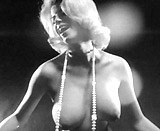 Lorna (Lorna Maitland) 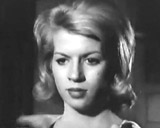  Lorna With Husband Jim    Lorna With Convict 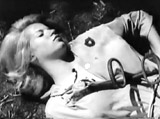 Lorna's Death |
||||||||||||||||||||||||
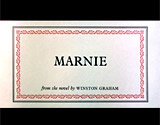
|
Marnie (1964) Alfred Hitchcock's tale of sexual perversity and obsession was billed as a 'sex mystery' with the questioning tagline:
It featured the prudish title character Marnie/Mary Edgar (icy blonde Tippi Hedren) who was sexually frigid. Her deep-seated problems were due to trauma when witnessing as a young 5 year-old (Melody Thomas Scott) her 20 year-old prostitute mother Bernice Edgar (Louise Latham) being attacked by sex partner and pedophile sailor (Bruce Dern)). Marnie was also a compulsive kleptomaniacal thief (who acquired power over men by stealing from them). The film featured handsome James Bond co-star Sean Connery as her blackmailing playboy boss and newly-wed husband Mark Rutland in a much-debated scene (was it passive rape or a case of frigidity?). During their honeymoon cruise to Fiji, he asserted: "I very much want to go to bed" - a euphemism for sleeping with her.
He hungrily advanced toward her, kissed her, ripped off her nightgown (the silky garment fell to her feet), embraced her, laid on top of her on the bed and took her (his face filling the entire screen). She stared upward in a frozen, paralyzed catatonic state - completely lacking any passion or emotion, but then the scene cut away to a porthole. In the scene of the revelation that Marnie had killed the sailor (although her mother stood trial in her place), Marnie's mother also admitted that at age 15, she had allowed a boy named Billy to have sex with her in exchange for his basketball sweater. |
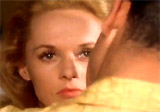 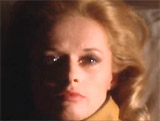 
|
||||||||||||||||||||||||
 Beach Party (1963)  Muscle Beach Party (1964)  Bikini Beach (1964) 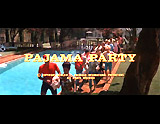 Pajama Party (1964)  Beach Blanket Bingo (1965) |
The Beach Party Film Series
(1963-1965): Beach Party (1963) This musical comedy was produced by American International Pictures (AIP) - a low-budget, exploitative, and successful film company founded in 1956. It was the first "beach" film (mostly showing in drive-in theatres), starring popular 24 year-old singer Frankie Avalon, now-buxom 21 year-old ex-Disney Mickey Mouse Club Mousketeer Annette Funicello (as Dolores or "DeeDee" in later films), Robert Cummings, and Dorothy Malone. AIP realized the lucrative buying power of this new demographic group and advertised the fluffy film alluringly: "It's what happens when 10,000 kids meet on 5,000 beach blankets." However, wholesome star Annette Funicello - still under contract to Disney, was legally forced to not appear in a bikini, and to express repressive sexual attitudes, although she wore a non-revealing two-piece suit! Pajama Party (1964) This follow-up film included more sexual innuendo. It starred Annette Funicello (as Connie) and poor substitute Tommy Kirk (her former Disney co-star), and Frankie Avalon only in a short, red-tinted cameo role as Socum. It was a low-budget teen film with lots of shimmying and shaking - about a teenage Martian named Go-Go (Kirk) who landed on Earth to study the lovemaking rituals of Earthlings and fell in love with Connie. |
 Pajama Party (1964)  Beach Blanket Bingo (1965) |
||||||||||||||||||||||||

|
Sidney Lumet's controversial yet mainstream film drama was condemned by the Legion of Decency although the MPAA gave it a seal of approval. It was the first US film to show a woman nude from the waist up with bare breasts that was granted a Production Code seal, because the nakedness was regarded as integral to the story. This ultimately broke the back of the Production Code's restrictions. It told about a Holocaust-surviving husband - a bitter old, upper Manhattan pawnbroker named Sol Nazerman (Rod Steiger) who had anesthetized himself emotionally. His breaking point came when a breast-baring black prostitute (Thelma Oliver), the girlfriend of his employee Jesus Ortiz (Jaime Sanchez), offered herself to him:
A fast series of clips alternated between shots of the prostitute, himself, and his brutal, intense flashbacks of Nazi guards readying themselves to sexually assault his humiliated wife Ruth (Linda Geiser) (also seen briefly topless) years before.
After witnessing the cruelty of the concentration camp, he now interpreted sex as dark and evil - he covered the young topless woman with her raincoat, and gave her a $20 dollar bill. |
 Sol Nazerman (Rod Steiger) 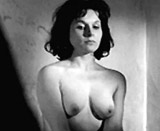   Ruth Nazerman (Linda Geiser) |
||||||||||||||||||||||||
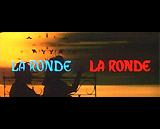 La Ronde (1964, Fr.)  La Ronde (1950, Fr.) |
La Ronde (1964, Fr.) (aka Circle
of Love) Director Roger Vadim adapted Arthur Schnitzler's controversial 1897 play "Reigen" that provided the basis for an adults-only remake titled La Ronde (1964, Fr.) (aka Circle of Love). It also served as the source material for Max Ophuls' 1950 film of the same name. The original film almost fifteen years earlier, La Ronde (1950, Fr.) (translated "the round-dance"), Max Ophuls' studio-bound, multi-character romantic drama of love and infidelity, was taglined:
The romantic drama received two Oscar nominations: Best Writing, Screenplay (Jacques Natanson, Max Ophuls), and Best Art Direction-Set Decoration (Jean d'Eaubonne). Ophuls was known for long, complex and innovative camera shots (via trolleys and cranes), and in this effort, the gliding camera swooped about gracefully. A Narrator/Raconteur (Anton Walbrook) dressed in a cape and top hat intertwined ten character vignettes (with interlocking affairs) set in Vienna in the early 1900s. Each stylish segment led to the next one when a new philandering character was introduced having an affair with a character from the previous scene. The guiding storyteller was depicted as the owner of a Vienna merry-go-round in 1900 (the film's centerpiece), who introduced each of the love affair episodes, involving:
The circular plot (a chain of romances) came full-circle by the end, when the Count encountered the prostitute from the first vignette. Prominent and rampant sexual misconduct appeared to transcend all class distinctions in French society. The remake was also about 'musical beds' (and a chain of sexual partners) and starred 27 year-old US actress Jane Fonda (Vadim's romantic partner at the time and future wife - and her first husband) in her 7th film. She was one of the first (or possibly the first!) major American actresses to appear nude in a foreign film - making the film more controversial than it actually was. It was the first of four films that Vadim directed with Fonda (she appeared nude or partially nude in three of the four films):
Vadim provided a more provocative tagline for his 1964 film:
The overtly-sexual, stylish, glossy and whimsical film (without overt nudity or vulgarity however, and horribly dubbed into English) was banned in New York (by the state's censorship board) for "immorality," and ended up being appealed all the way to the Supreme Court. Vadim's film, considered very risque and naughty in the mid-60s, was charged with being obscene in Italy in 1967. According to news reports at the time, many "half-clothed" scenes of the sex farce were substituted for "nudie' scenes to comply with US censorship codes and regulations. A giant 8-story billboard in New York City's Times Square of Fonda reclining in the nude was draped with a canvas when an offended Fonda sued the producers for $3 million to demand that her image was covered. |
|
||||||||||||||||||||||||
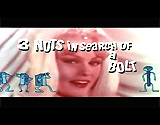
|
3 Nuts in Search of a Bolt (1964) Writer/director Tommy Noonan also starred as Himself in this unfunny and unusual low-budget sex comedy that was taglined: "The Screwiest Comedy of the Year." The ribald screwball comedy was heavily publicized by nude photos of Mamie in a bathtub in issues of Playboy Magazine (although she refrained from being nude in the film). It was one of the earliest films to have a big-name actress appear in various states of undress. It hoped for the success of Noonan's previous film Promises! Promises! (1963) with blonde bombshell Jayne Mansfield. The mostly black/white film tipped off the viewer to the potentially sexy scenes - they were in color. Mamie Van Doren played the role of Saxie Symbol, calling herself "an exotic dancer" instead of a stripper (or an ecdysiast). She met a struggling out-of-work method actor/comedian Tommy Noonan (as Himself) in an unemployment line, and brought him back to her apartment, where she lived with two roommates (they called themselves "The Three Nuts"):
To save money, the three "nuts" hired the newest roommate Tommy Noonan to listen to their problems so they all wouldn't have to pay to see a therapist. Then he would relate their problems to renowned headshrinker Dr. Myra Von (Ziva Rodann) - and report back. He acted out their psychological neuroses during a one-hour appointment, in twenty-minute segments. When his recorded therapeutic sessions were accidentally aired on television, the viewing public became fascinated by his unique 'split-personality' and its problems.
|
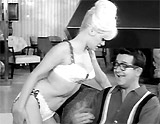 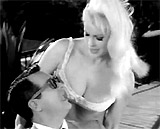
Saxie Symbol (Mamie Van Doren) |
||||||||||||||||||||||||